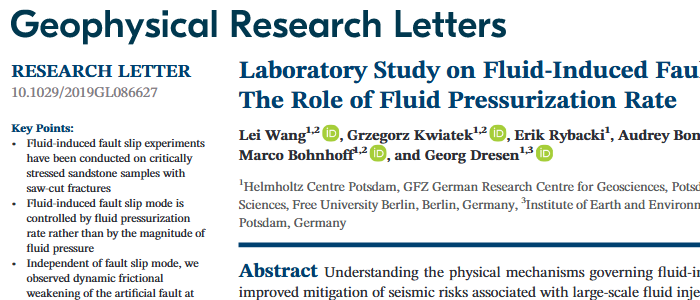We published another paper in Geophysical Research Letters entitled “Laboratory study on fluid-induced fault slip behavior: The role of fluid pressurization rate”. The work is a part of PhD of our student Lei Wang. The paper is open access and freely available to download.
Reference:
Wang, L., G. Kwiatek, E. Rybacki, A. Bonnelye, M. Bohnhoff, and G. Dresen (2020). Laboratory study on fluid-induced fault slip behavior: The role of fluid pressurization rate, Geophysical Research Letters, DOI: 10.1029/2019GL086627. [ Article Page ] [ Open Access online PDF ] (published)
Summary:
Human‐induced earthquakes from field‐scale fluid injection projects including EGS and deep wastewater injection have been documented worldwide. Although it is clear that fluid pressure plays a crucial role in triggering fault slip, the physical mechanism behind induced seismicity still remains poorly understood. We performed two fluid‐induced slip experiments conducted on permeable Bentheim sandstone samples crosscut by a fault that is critically stressed. Fault slip is then triggered by pumping the water from the bottom end of the sample at different fluid injection rates. Our results show that fault slip is controlled by fluid pressure increase rate rather than by the absolute magnitude of fluid pressure. In contrast to episodes of relatively rapid but stable sliding events caused by a fast fluid injection rate, fault creep is observed during slow fluid injection. Strong weakening of the dynamic friction coefficient of the experimental fault is observed at elevated pore pressure, independent of fault slip mode. These results may provide a better understanding of the complex behavior of fluid‐induced fault slip on the field scale
